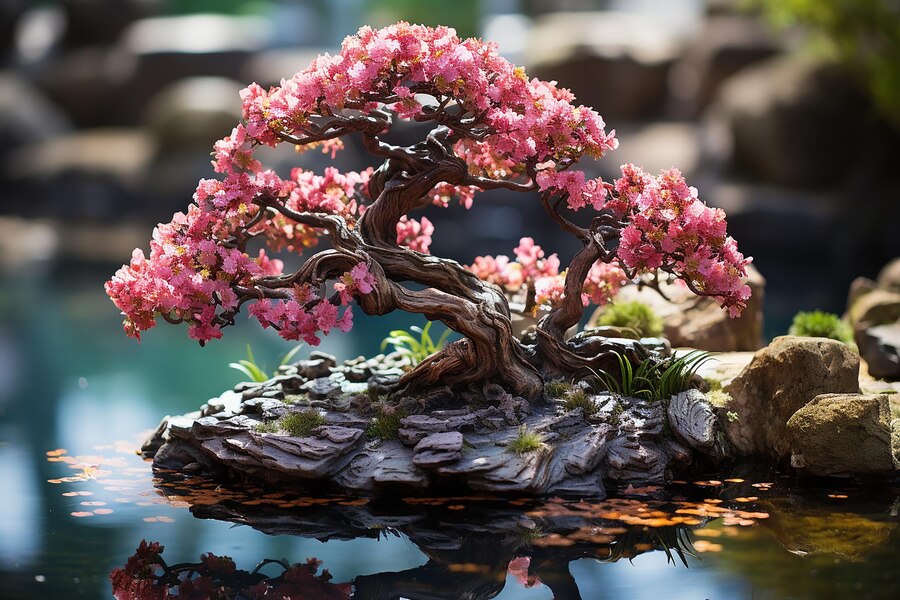Introduction
Wisteria bonsai trees are renowned for their breathtaking beauty and serene elegance, capturing the essence of traditional Japanese aesthetics in miniature form. These exquisite bonsai specimens, adorned with cascading clusters of fragrant flowers, evoke a sense of tranquility and natural grace. This article explores the characteristics of wisteria bonsai trees, cultivation techniques, and the cultural significance they hold in the art of bonsai.
Characteristics of Wisteria Bonsai Trees
- Flowering Beauty: The hallmark of wisteria bonsai trees is their spectacular floral display. During the springtime, wisteria bursts into cascades of pendulous blooms in shades of lavender, pink, white, or blue, depending on the species and cultivar.
- Graceful Form: Wisteria bonsai trees are admired for their graceful, vine-like growth habit. The branches and stems cascade and twist elegantly, creating a sense of movement and natural flow characteristic of mature wisteria vines.
- Fragrance: In addition to their visual appeal, wisteria flowers emit a delicate, sweet fragrance that enhances their allure. This fragrance adds an extra dimension to the sensory experience of observing and caring for a wisteria bonsai.
- Seasonal Changes: Like all bonsai, wisteria trees undergo seasonal changes that reflect the rhythms of nature. In winter, the deciduous foliage drops, revealing the elegant structure of the branches. Spring brings the profusion of flowers, followed by lush green foliage in summer and potentially a second flush of blooms in autumn.
Cultivation Techniques
Cultivating and caring for wisteria bonsai trees requires patience, attention to detail, and an understanding of their specific needs:
- Sunlight: Wisteria bonsai thrive in full sun to partial shade. Adequate sunlight promotes healthy growth and abundant flowering. However, protection from intense afternoon sun during hot summers is beneficial to prevent leaf scorch.
- Watering: Wisteria bonsai trees prefer consistently moist soil during the growing season. Ensure the soil is well-draining to prevent waterlogged roots, which can lead to root rot. Adjust watering frequency based on environmental conditions and the moisture needs of the tree.
- Pruning and Training: Pruning is essential to maintain the compact size and elegant form of wisteria bonsai. Regular pruning of shoots, branches, and roots encourages ramification (branch development) and enhances the tree’s overall aesthetics. Training the branches with wire helps create the characteristic cascading effect of wisteria.
- Feeding: Fertilize wisteria bonsai trees regularly during the growing season with a balanced bonsai fertilizer. This promotes healthy growth, flowering, and overall vigor. Reduce or stop fertilization during the dormant winter months.
- Repotting: Repot wisteria bonsai every two to three years to refresh the soil, prevent root-bound conditions, and promote healthy root growth. Use a well-draining bonsai soil mix tailored to the specific needs of wisteria.
Cultural Significance
In Japanese culture, wisteria (known as “fuji” in Japanese) holds symbolic importance and is often featured in art, literature, and gardens:
- Symbol of Longevity and Beauty: Wisteria symbolizes longevity, endurance, and beauty in Japanese aesthetics. Its graceful vines and abundant flowers are celebrated in traditional tea gardens, temples, and imperial landscapes.
- Zen and Tranquility: Wisteria’s cascading form embodies the Zen principles of simplicity and tranquility. In bonsai form, wisteria encourages contemplation and appreciation of nature’s beauty.
- Festival Celebrations: In Japan, wisteria festivals (Fuji Matsuri) are held during the peak blooming season to celebrate the beauty of wisteria. Visitors admire spectacular wisteria arbors and bonsai displays, reveling in the ephemeral beauty of the blooms.
Conclusion
Wisteria bonsai trees are not merely horticultural specimens but living works of art that embody elegance, beauty, and cultural significance. Cultivating a wisteria bonsai requires dedication and skill, rewarding enthusiasts with breathtaking floral displays and a connection to centuries-old traditions of bonsai and Japanese aesthetics. Whether adorning a private garden or showcased in a bonsai exhibition, wisteria bonsai trees inspire awe and admiration, inviting contemplation of nature’s splendor and the artistry of bonsai cultivation.










